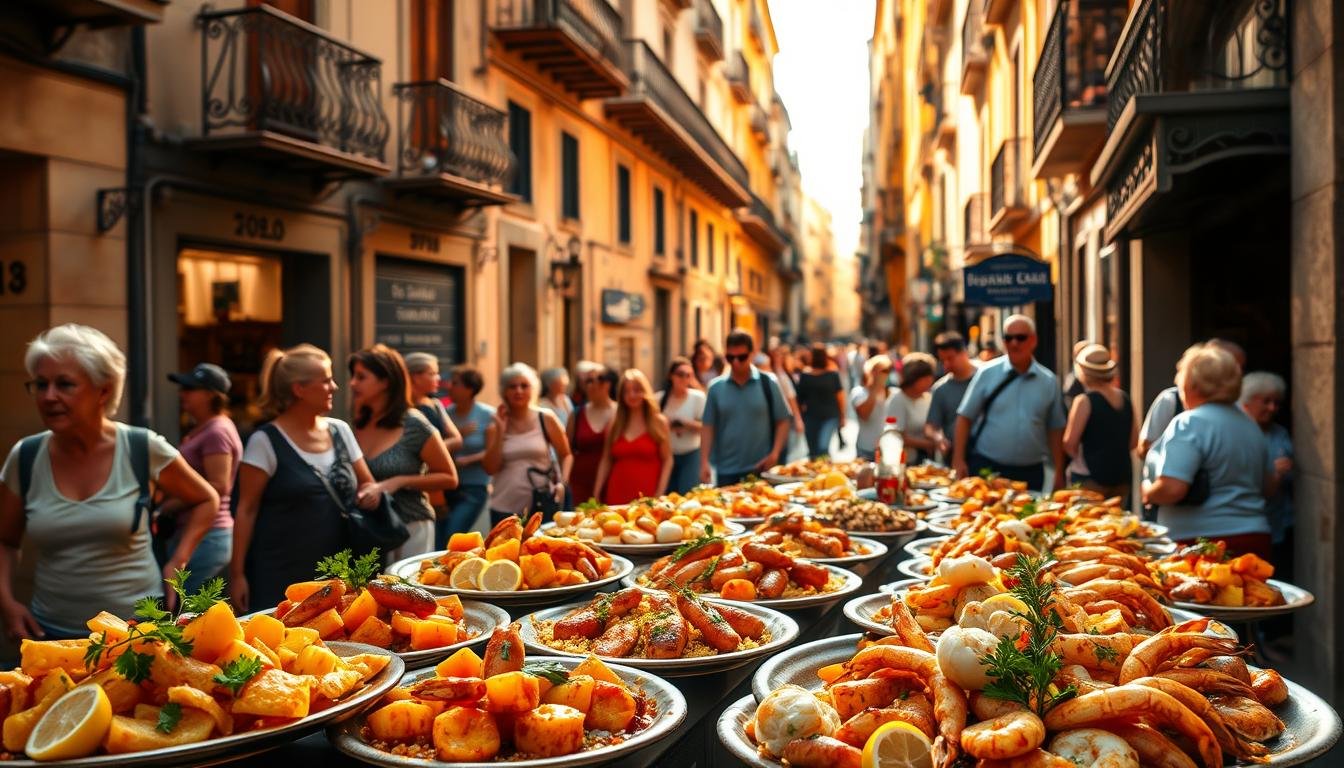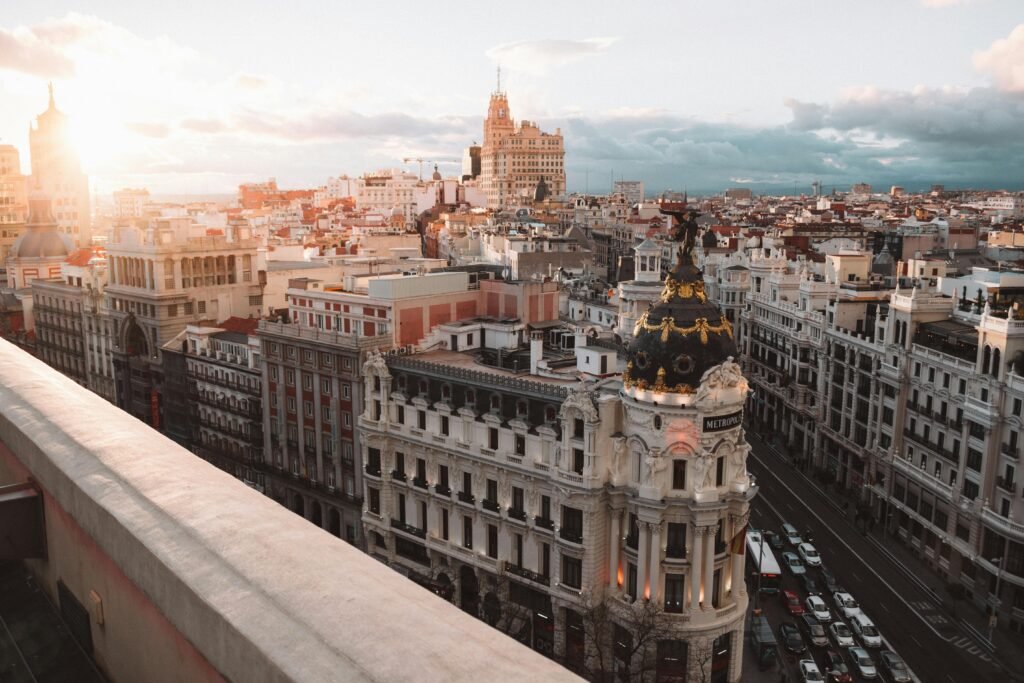
Breathtaking view of Madrid’s skyline at sunset featuring the Metropolis Building.
Madrid’s streets are alive with food, making every visit unforgettable. Start your journey early in a bustling mercado. The smell of serrano ham and roasted peppers fills the air, mixed with vendor chatter. Here, Spanish food comes to life, blending tradition with new ideas.
Madrid’s food scene is diverse, from Mercado de la Paz’s rustic feel to DiverXO’s modern twist. You’ll see Michelin-starred chefs update classics like cocido madrileño. Each visit makes you want to explore more, from cozy tapas bars to Michelin-starred spots.
This guide takes you to Madrid’s heart, through markets and Michelin-starred places. For personalized tips or to learn more about Madrid’s food, plan your culinary tour of Madrid. Every dish here has a story to tell—are you ready to listen?
Key Takeaways
- Madrid’s markets and Michelin restaurants coexist as pillars of its culinary identity
- Spanish gastronomy in Madrid thrives where tradition meets bold experimentation
- Every mercado visit offers an authentic taste of Madrid’s cultural soul
- Micelin-starred chefs in Madrid redefine dining without losing local soul
- A Madrid dining experience balances discovery and indulgence effortlessly
The Culinary Soul of Spain’s Capital City
Walking through Madrid’s bustling markets, you can taste the heartbeat of Madrid food culture. It’s a mix of old traditions and new ideas. Every dish here tells a story. From the timeless flavors of Spain
Madrid’s Unique Position in Spanish Gastronomy
Madrid is at the heart of traditional Spanish cuisine. It’s a place where Spain’s regional dishes come to life. From the hearty cocido madrileño to Basque pintxos, every dish has a story. Each neighborhood in Madrid is like a small culinary region.
A City Where Tradition Meets Innovation
Chefs like Dabiz Muñoz mix old with new. They take classic dishes and add a modern twist. Places like Coque and Bistró de la Estación show how Madrid’s kitchens are where tradition meets creativity. The result is dishes that look back while reaching forward.
Why Madrid Deserves Your Gastronomic Attention
Madrid is a city where food culture shines. From early morning churros to late-night tapas, there’s always something new to try. Markets like Mercado de San Miguel are filled with flavors from the past and present. Madrid’s food scene offers unforgettable experiences that show off Spain’s culinary spirit.
Why Madrid’s Food Scene Outshines Barcelona
Madrid and Barcelona both offer amazing food, but Madrid stands out. It’s not just about fancy restaurants. It’s about the heart of its streets. In Madrid, you can taste the tradition in every dish.
Visit Mercado de San Miguel and you’ll feel the city’s warmth. Vendors treat you like family, not just another face. This is what makes Madrid special.
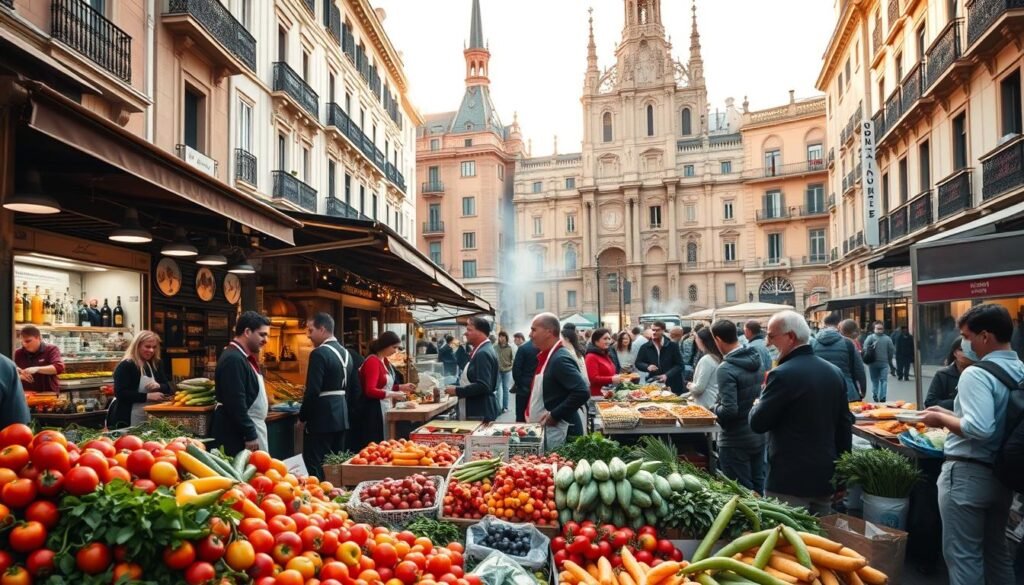
Madrid’s chefs keep their roots close to their hearts. At DiverXO, Dabiz Muñoz makes old favorites new again. This shows that tradition and innovation can go hand in hand.
Barcelona’s food scene is exciting too, but it’s different. It often mixes global flavors with Spanish ones. But in Madrid, you can enjoy delicious meals without spending a lot. A big plate of cochinillo won’t empty your wallet.
A local chef once said,
“Madrid’s kitchens are time machines—every bite tastes like Spain’s history.”
Madrid’s food is a mix of old and new. You can enjoy a drink at a historic bar or follow the smell of saffron to a local kitchen. Madrid’s food scene is a journey through time.
Planning Your Ultimate Culinary Tour of Madrid Spain
Starting a Madrid culinary itinerary means finding the right mix of discovery and planning. Here is the top tips for exploring Madrid’s food scene. For a personalized experience, check out Epicurean Escape’s special routes. They blend traditional Madrid with modern tastes.
Best Times of Year for Food Tourism
Spring and autumn are the best times for food tourism in Madrid. Skip the heat of August. November is great for exploring best Madrid food neighborhoods with chestnut vendors and hearty stews. Don’t miss June’s San Isidro Festival for big chuletón celebrations.
Neighborhoods for Food Enthuasiasts
Madrid’s food scene is divided into four main areas:
| Neighborhood | Vibe | Highlights |
|---|---|---|
| Chamberí | Timeless tradition | Tapas bars like Taberna La Latina; historic jamón ibérico counters |
| Malasaña | Innovative small plates | Pintxos bars like La Vara and hidden wine cellars |
| Lavapiés | Global melting pot | Peruvian cevicherías and Moroccan tagine spots |
| Salamanca | Michelin-starred elegance | DiverXO and Cincoro’s avant-garde tasting menus |
Transportation Tips Between Food Destinations
Travel like a local: Use Metro lines 2-10 for Madrid food tour planning. Explore Malasaña’s streets on foot. Bus 148 connects Chamberí to Salamanca. Get to Mercado de San Miguel early for the best cured ham.
The Magic of Madrid’s Mercados
Walking through Madrid’s food markets, you’re hit with a burst of colors, sounds, and smells. These markets are more than places to buy food. They’re where Madrid’s food history comes alive every day. At dawn, stalls are filled with fresh produce, like red pimientos de padrón and citrus.
The market culture here is all about people. Vendors know regulars by name and share tips. You’ll see families haggling over Manchego cheese, laughing with the fishmongers arranging Galician octopus.
- Galician seafood arrives daily, glistening under skylights
- Manchego cheese wheels age in open-air shops
- Andalusian olive oils cascade into bottles like liquid gold
A local once said:
“Here, every vegetable has a story; every stallkeeper is a historian.”
Madrid’s markets are where tradition and community come together. They nourish both body and soul.
These markets are the heart of Spain’s flavors, yet they’re personal. Have café con leche at dawn, as you listen to vendors’ stories. It’s a moment where time stands, and fresh jamón iberico or artichokes from Tudela feel like a secret shared.
As you explore, you’ll realize Madrid’s markets are more than markets. They’re the heart of Spain’s culinary soul, untouched by time. And this is where your journey into their wonders truly begins.
Mercado de San Miguel: The Jewel in Madrid’s Crown
Walking through Mercado de San Miguel Madrid is like stepping back in time. This historic spot was once a simple produce market. Now, it’s a top food market in Madrid, filled with stories of tradition.
The San Miguel market food here is more than just food. It’s an experience. You’ll see oyster shuckers and jamón carvers creating art from acorn-fed pork.
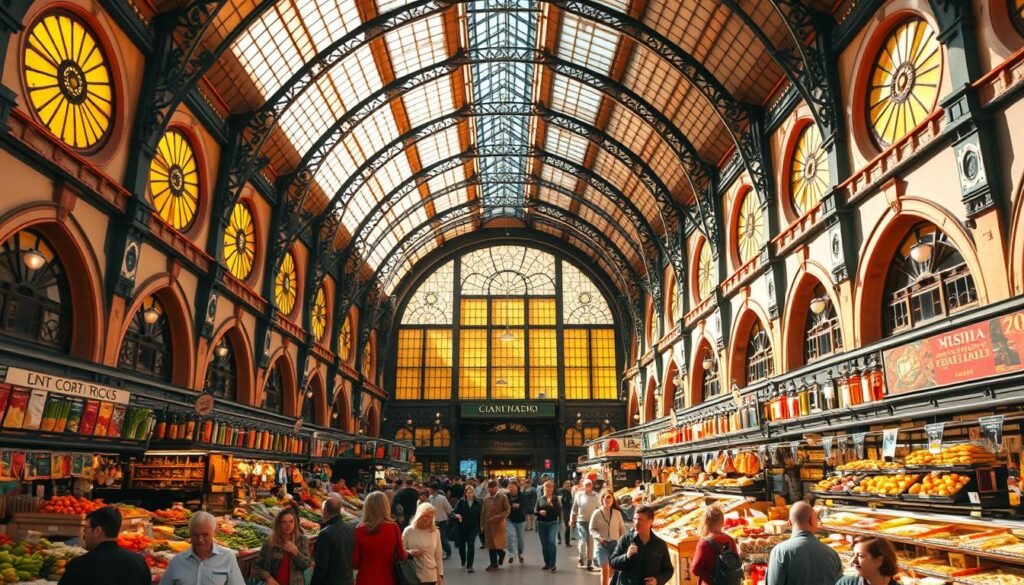
History and Transformation
This market opened in 1916 and was a staple for decades. In 2009, it got a new life. Its old ironwork now holds modern food creativity.
The renovation kept the old charm while bringing in new chefs. Every visit is a mix of old and new.
Must-Try Stalls and Specialties
- Oyster Bar: Fresh Pacific oysters with citrus and chili oil. It’s a briny delight best enjoyed early in the morning.
- Jamón Ibérico Counter: See artisans slice 100% ibérico pork. Its marbled richness is a treat for your taste buds.
- Vermutería: Try sweet or dry vermouth with quince paste. It’s a tradition locals have followed for a century.
Insider Tips for Beating the Crowds
Get there at 10 AM to enjoy San Miguel market food before the crowds arrive. On weekends, use the rear entrance near Calle de la Paja for shorter lines. For a quiet spot, head to the northeast corner by the glass-domed atrium.
Whether it’s enjoying cava at dusk or exploring the market’s ironwork at noon, Mercado de San Miguel Madrid is a feast for your senses. It shows the heart of Madrid’s culinary scene.
Beyond San Miguel: Hidden Market Gems Locals Love
Madrid’s most authentic Spanish mercados are hidden from guidebooks. The favorite local Madrid markets are alive with real life. Here, you can swap recipes with vendors for years.
Visit Tetuán and explore Mercado de Maravillas. It’s filled with the sounds of paella pans and the smell of chorizo. A third-generation butcher shows Iberico ham cuts, sharing stories as old as the market.
“In Spain, seasons dictate the table,” said a fruit vendor at Mercado de la Paz. Salamanca’s elite and immigrants debate avocado varieties here. His words captured Madrid’s culinary rhythm.
For off the beaten path Madrid food, go to Lavapiés’ Mercado de San Fernando. It’s a mix of tradition and innovation. You’ll find empanada stands next to matcha latte bars.
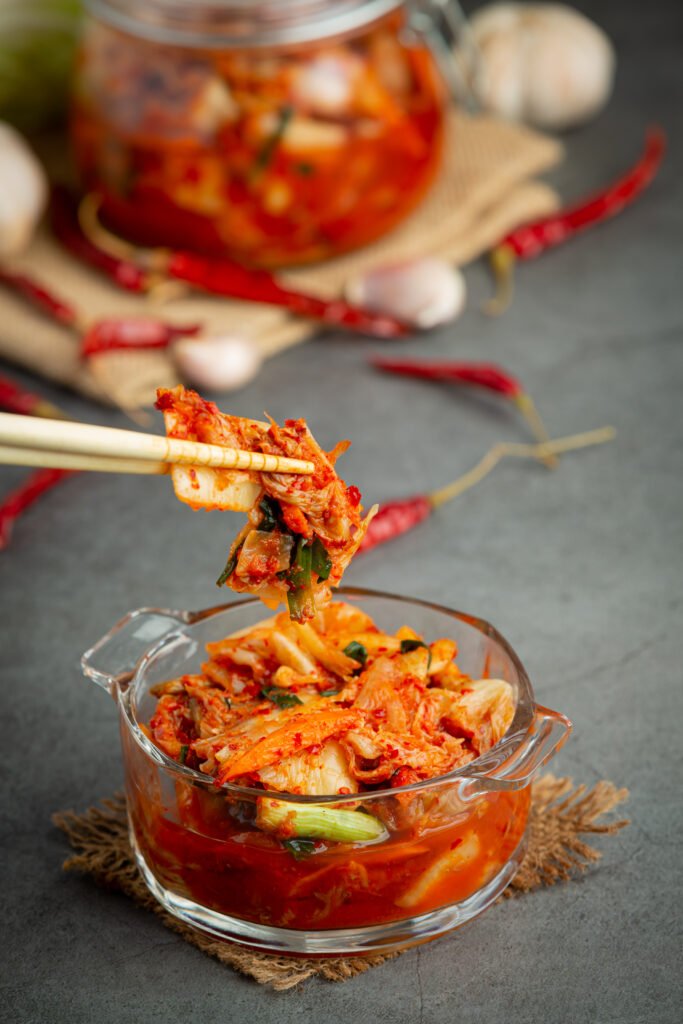
Kimchi ready to eat in bowl
Nearby, Mercado de los Mostenses surprises you. It has Korean kimchi stalls and Andalusian olive oil sommeliers. Madrid’s markets are living cultural mosaics.
| Market | Neighborhood | Highlight | Pro Tip |
|---|---|---|---|
| Mercado de Maravillas | Tetuán | Generational butcher shops | Arrive at dawn for fresh serrano hams |
| Mercado de San Fernando | Lavapiés | Multicultural fusion | Try the Colombian arepas at La Casona |
| Mercado de la Paz | Salamanca | Luxury ingredients | Sample aged Manchego at Quesería La Tradición |
| Mercado de los Mostenses | Retiro | Global flavors | Pair Thai curries with local Albariño wines |
These neighborhood markets Madrid are more than shopping spots. They’re where the city’s soul is cooked, debated, and shared. Follow locals and taste Madrid as it truly is.
The Rise of Madrid’s Michelin Star Revolution
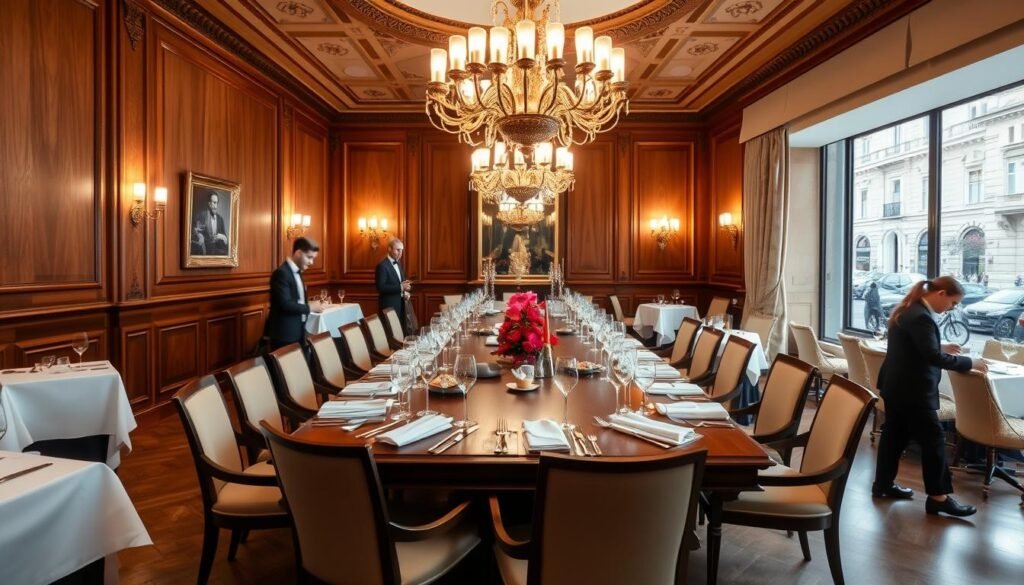
In recent years, Madrid’s food scene has changed a lot. It’s now known for Madrid Michelin restaurants and fine dining Madrid. It has grow from simple tapas bars to fancy places. Now, over 25 places in Madrid have Michelin stars, showing its growth.
Madrid’s Journey to Culinary Excellence
Not long ago, Madrid was behind Barcelona and San Sebastián in Michelin stars. But chefs like Ángel Lezaola and Paco Roncero changed that. They mixed local flavors with new techniques, getting praise worldwide.
Their dishes, like Iberico pork with smoked almond foam or truffle gazpacho, showed Madrid’s talent. They proved Madrid could match any big city in Europe.
Current Michelin Star Count and Distribution
By 2024, Madrid will have 3 three-star, 12 two-star, and 11 one-star restaurants. They’re mainly in Salamanca and Chamberí. This makes areas where new ideas in food can grow.
| Star Level | Number of Restaurants | Notable Examples |
|---|---|---|
| 3 Stars | 3 | DiverXO, Coque, Santceloni |
| 2 Stars | 12 | Casa Lucio, Arzak Abastos, Bocaditos |
| 1 Star | 11 | Botín, La Vía Láctea, Cinc Sentits |
What Makes Madrid’s Fine Dining Unique
- Cultural mosaic: Dishes mix Castilian classics with international touches, like Barcelona’s creativity but with Madrid’s heart.
- Sensory storytelling: Places like DiverXO offer meals that tell stories of Spain’s food history through each bite.
This change is more than just stars. It’s celebrating Madrid’s spirit. Every meal here respects tradition but also explores new flavors.
DiverXO: A Deep Dive into Dabiz Muñoz’s Three-Star Wonderland
Walking into DiverXO Madrid is like stepping into a dream world. It’s one of the three Michelin stars Madrid boasts, known for its avant-garde Spanish cuisine. Chef Dabiz Muñoz’s Dabiz Muñoz restaurant breaks the mold, with each dish telling a unique story. The entrance is a scene from a dream, with flying pig sculptures and blue lights.
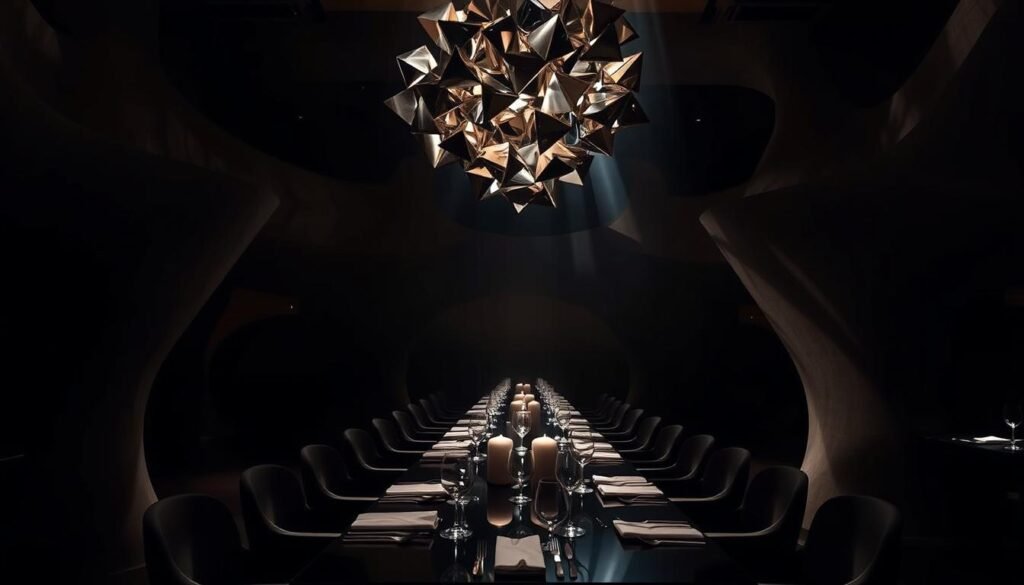
“Cuisine is theater,” Dabiz Muñoz once said. His words come alive in every bite. The tasting menu is a feast for the senses, with dishes like Galician lobster traveling to Korea and a painted piglet that looks like art. Chefs act out the story behind each dish.
| Dish | Description | Fusion Elements |
|---|---|---|
| Galician Lobster | Shellfish meets Korean spices | Spanish ingredients + Asian techniques |
| Painted Piglet | Roasted pork with edible paint | Tradition reimagined through art |
| Chocolate Volcano | Hot chocolate eruption dessert | Childhood nostalgia meets avant-garde |
Getting a table here takes months of planning. The 200+ euro tasting menu is a big investment, but it’s worth it. For those looking for something new, DiverXO is a must-try. It’s not just a meal; it’s a conversation between Madrid’s past and global flavors. Here, Muñoz’s bold style meets Michelin excellence, showing that new can be comforting too.
Affordable Luxury: Michelin Experiences That Won’t Break the Bank
Madrid’s food scene is all about great taste and good prices. You’ll find places where Michelin-starred dishes are affordable. For those looking for budget fine dining Madrid has plenty to offer.
One-Star Restaurants with Exceptional Value
At Kabuki Wellington, dishes like black cod misoni and wagyu tartare are both precise and affordable. El Barrio de José offers creative tapas at half the price of two-star places. These spots show you can enjoy top Spanish-Japanese food without spending a lot.
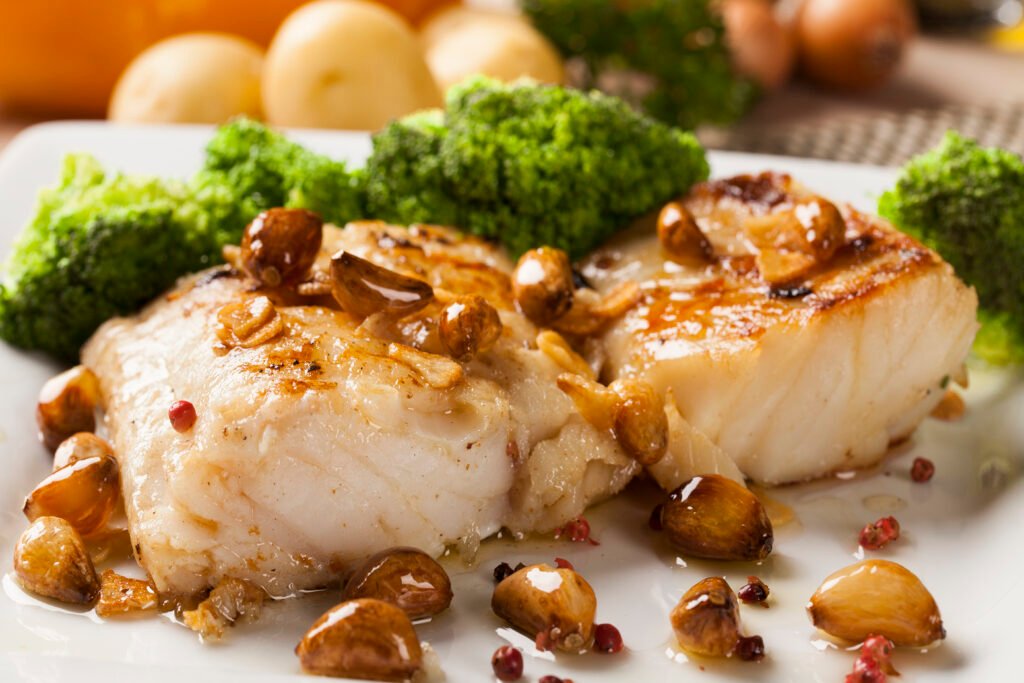
Codfish – fish fillet in sauce with garlic and vegetables
Bib Gourmand Alternatives
“A Bib Gourmand isn’t just a sticker—it’s a promise of soulful food at reasonable prices,”
One chef explained. Casa Dani’s potato omelette is under €10 and rivals Michelin-starred dishes. Taberna Pedraza offers a modern twist on cocido madrileño for under €30 per person.
Lunch Tasting Menus Worth Trying
| Restaurant | Highlight | Price |
|---|---|---|
| La Tasquería | Offal masterpieces | €45 |
| Coque Lunch Menu | Two-star essence | €65 |
Coque’s midday menu is a great deal, with creative dishes at a lower price. These Madrid lunch tasting menus let you enjoy new flavors without the high evening prices.
Madrid shows that fine dining doesn’t have to be expensive. From Bib Gourmand spots to creative lunch deals, the city offers a wide range of dining options. Your taste buds and wallet will appreciate it.
Bridging the Gap: Mid-Range Dining Experiences in Madrid
Mid-range Madrid dining is a perfect mix of tradition and affordability. It offers a glimpse into the city’s soul through authentic Madrid eateries. These places are more than just places to eat; they are gateways to the city’s heart. Find spots where locals enjoy tapas at hidden culinary gems, like the historic tabernas where time seems to freeze.
- Casa Lucio: Politicians and locals flock here for their famous huevos estrellados. It’s a simple yet amazing dish of fried eggs with tomato. This place embodies the essence of Madrid’s culinary scene.
- La Tasquita de Enfrente: Here, fresh seafood is the star, from briny sea snails (cañaillas) to paella cooked in clay pots. The lively counter seats reflect the city’s love for communal dining.
- Angelita Madrid: A modern bistro where seasonal vegetables are the main attraction. Their wine pairings are expertly chosen, showing why Madrid’s mid-range dining is on par with Michelin-starred places.
These best Madrid restaurants strike a perfect balance. They are casual yet precise, traditional yet creative. At Cualquiera, their arroz dishes are as good as Valencia’s famous paella. This shows that mid-range dining doesn’t mean sacrificing quality. Step into any of these places, and you’ll be greeted like family, a true sign of Madrid’s hospitality.
Mid-range Madrid dining is more than just about the price. It’s a celebration of skill and tradition. Whether you’re sipping sherry at an old bar or discussing octopus with a chef, these places encourage you to stay and enjoy. They are the pulse of Madrid’s culinary scene, where every dish has a story to tell.
Conclusion: Creating Your Perfect Madrid Food Journey
Madrid’s food scene is a mix of old and new. You can explore bustling markets or try modern dishes. A good food plan in Madrid includes both traditional and modern spots.
Start your day with cheese and cured meats at Mercado de la Paz. Then, enjoy a fancy dinner at Arzak. A tour could include tapas in La Latina and a visit to Tickets by José Andrés.
It’s best to have one fancy meal a day. This way, you won’t get too full. Try to mix markets like San Anton with Michelin-starred places like Santceloni.
For a three-day trip, visit Mercado de Rastro, then tapas bars in Chamberí. End with a tasting menu at Bibo. Or, add Segovia for roast suckling pig and Mercado de Atocha for a morning.
Madrid is special because of its friendly vibe. Sharing food with strangers is common here. It’s about enjoying good food and making memories.
Remember, the best food experiences are those that let you explore and taste new things. For more ideas, check out Verona’s culinary heritage. Bon voyage—and enjoy your food!


